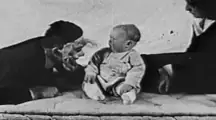There have been some unethical experiments throughout history, but one involving a nine-month-old boy might be one of the worst.

Back in 1919, psychologist John B. Watson and his graduate student Rosalie Rayner were on a mission: to find out if classical conditioning worked on humans.
So they set their sights on a nine-month-old baby, later known as ‘Little Albert’ or ‘Albert B’, per Very Well Mind.
Watson and Rayner exposed the little boy to a series of unusual stimuli: a rabbit, a monkey, a white rat, and even burning newspapers. At first? Totally chill. Albert hadn’t seen any of them before, so he had no fear.
But then things took a dark turn.
Watson began introducing a loud noise by smashing a metal pipe with a hammer, every time he showed Albert the white rat.
Unsurprisingly, the baby would cry. And after doing this enough times, Albert didn’t need the noise anymore. Just seeing the rat made him break down in tears.

The experiment quickly went down in history as one of the most unethical psychological studies ever conducted.
And after it ended, a mystery emerged: What happened to Little Albert?
For years, researchers tried to uncover the baby’s true identity. One of them, Hall Beck from Appalachian State University, believed he had cracked the case, per the American Psychological Association.
Watson’s records mentioned that Albert B was the child of a wet nurse working at Johns Hopkins University Hospital in Baltimore, where the experiment had taken place.

Beck dug into birth records, analyzed old photographs, and concluded in 2009 that Albert was actually Douglas Merritte, a boy born on the same day.
But this revelation came with heartbreak. Douglas Merritte had died at the age of six from hydrocephalus (a buildup of fluid in the brain), which had even caused periods of blindness during his short life.
However, not everyone was sold on Beck’s theory.
Enter Russ Powell from MacEwan University in Alberta, Canada, per the British Psychological Society.
Powell and his team took a second look and found something Beck had missed: another baby boy born the same day at the same hospital, named William Albert Barger.
Powell’s team said the evidence actually matched Barger more closely than Merritte and concluded he was the real Little Albert.
And here’s the twist: unlike Merritte, Barger lived a long, fulfilling life and passed away in 2007.
Even more intriguing? According to his niece, Barger never knew about the experiment, but did have a lifelong aversion to animals.
